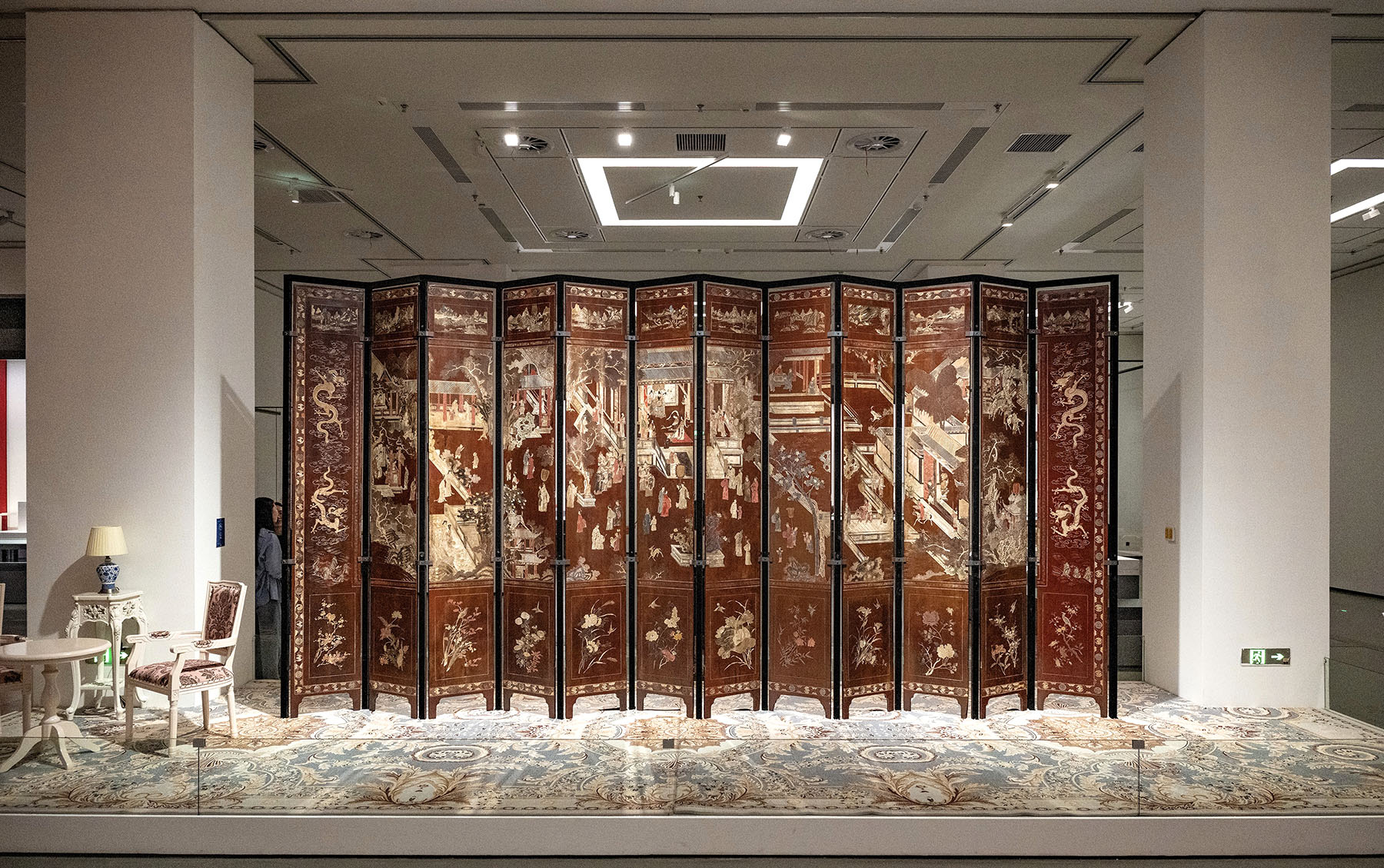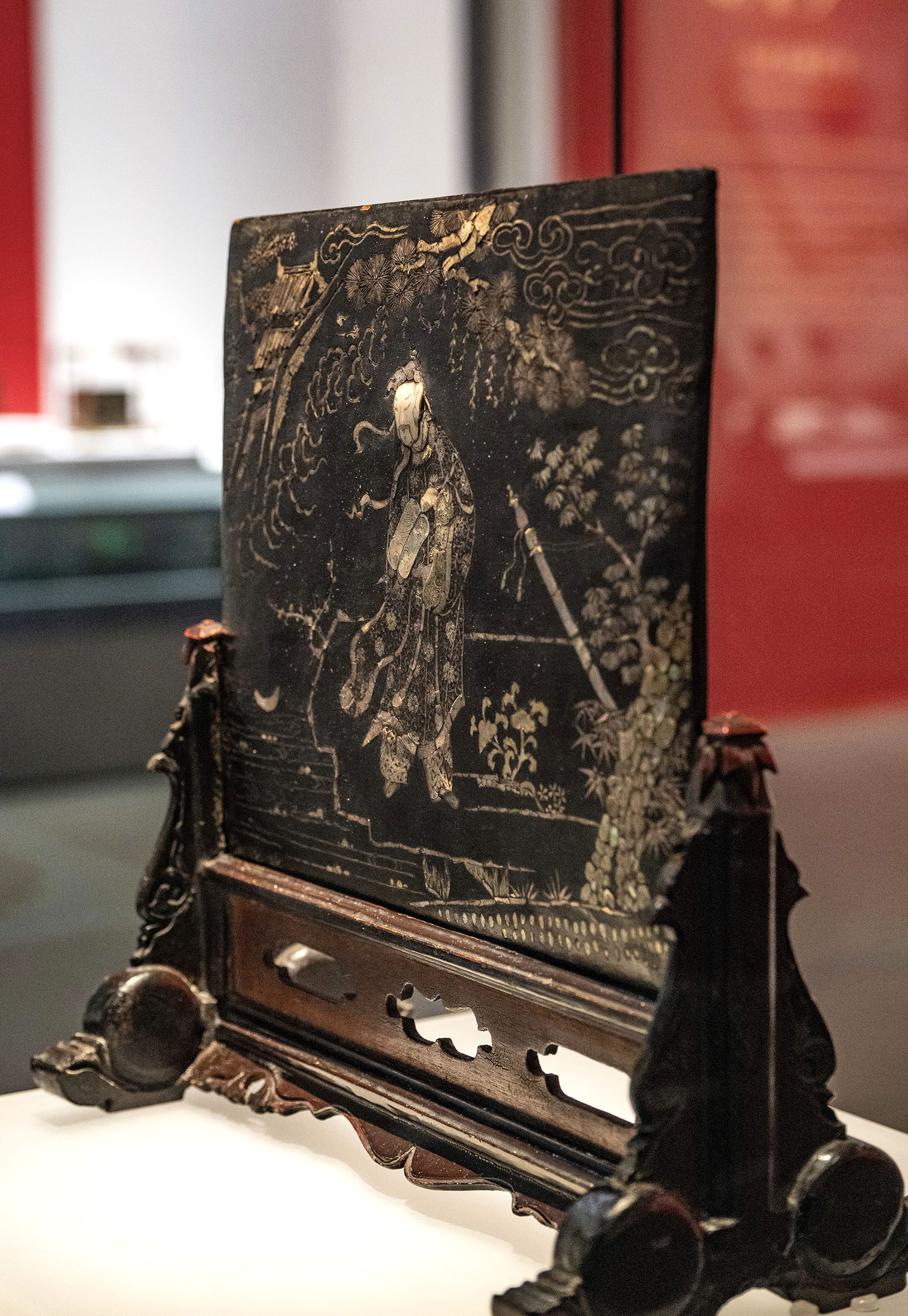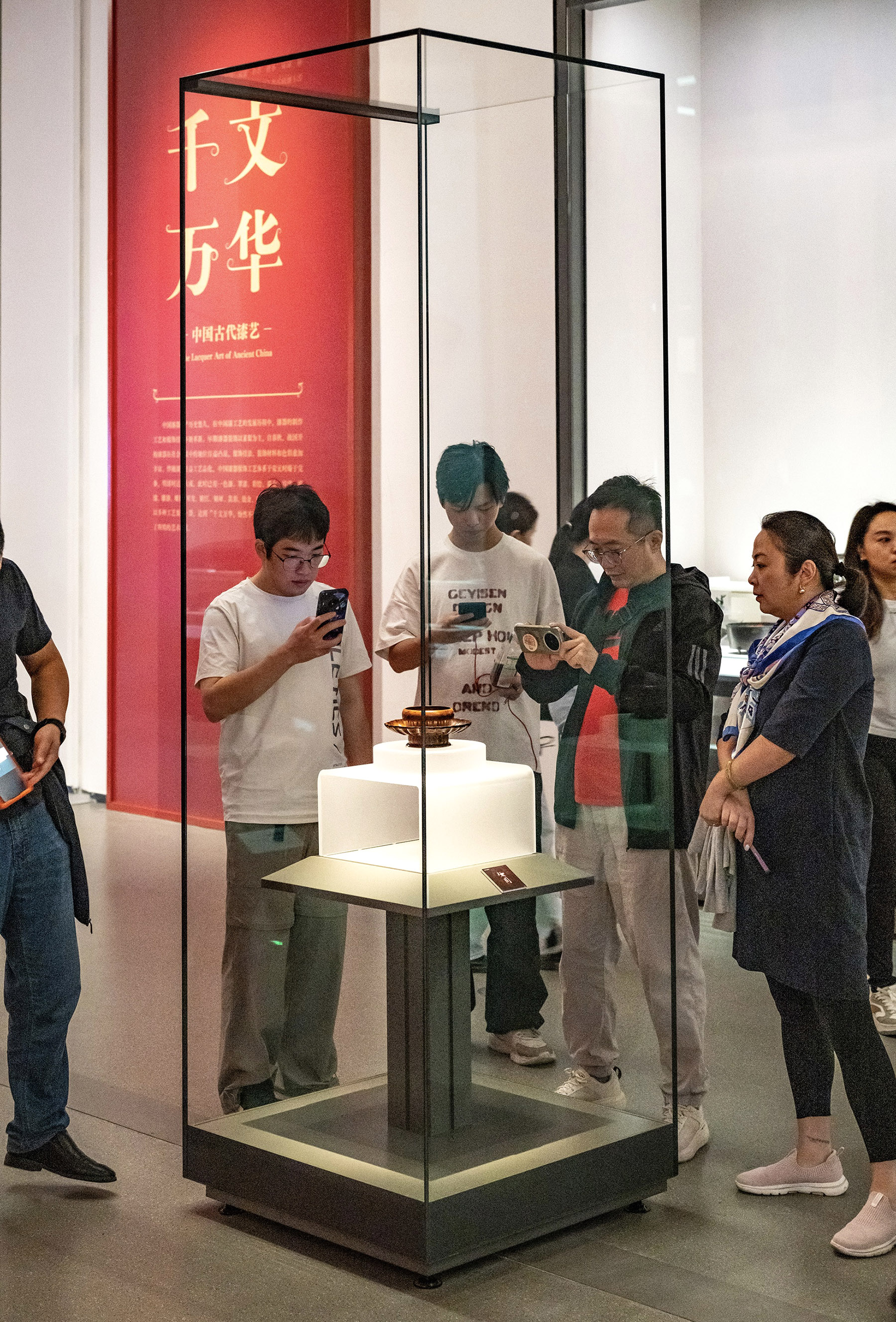Exhibition traces thousands of years of artistry, from craftsmanship and global influence to modern restoration, report Xu Lin and Liu Kun in Wuhan.

Visitors admire the delicate patterns on lacquered plates and bowls, but a collective sense of wonder overcomes them when they stand before a large lacquered screen adorned with scenes of ancient architecture and vivid figures.
China is known as the world's earliest country to discover and utilize natural lacquer. Its tradition of lacquerware dates back about 8,000 years based on solid archaeological findings, and has endured uninterrupted to the present day.
The exhibition The Art of Chinese Lacquerware at the Hubei Provincial Museum in Wuhan, which opened at the end of September and will run until Jan 4, 2026, is being co-hosted by the provincial museum and the Asian Art Museum of San Francisco, in the United States. It demonstrates ancient Chinese and contemporary lacquer art, and the conservation and restoration of excavated lacquer objects.
READ MORE: A many layered affair
A total of 180 pieces (sets) are on show, including those in the collection of Hubei Provincial Museum, and dated to the Warring States Period (475-221 BC), Qin (221-206 BC) and Han (206 BC-AD 220) dynasties. These are complemented by 81 pieces (sets) carefully selected from the San Francisco museum's collection, from the Song (960-1279), Yuan (1271-1368), Ming (1368-1644) and Qing (1644-1911) dynasties. The event marks the first large-scale exhibition of the US museum's lacquerware collection.

Together, these works represent the very peak of lacquerware development in China. The exhibition also features exquisite artifacts from six other Chinese museums, including the Hunan Museum, in Changsha, and Hubei's Jingzhou Museum, along with contemporary artworks from the Hubei Museum of Art that have been created by domestic and international artists.
"The exhibition embodies the importance of cultural exchange between China and the US. Such high-level cultural interactions can not only strike an emotional chord with the public but also facilitate more meaningful dialogue between nations," says Jay Xu, retired director of the Asian Art Museum of San Francisco.
"China possesses the world's most diverse lacquerware craftsmanship and the longest history of production ... The crafting techniques of lacquerware have been continually refined over different eras, giving rise to a rich diversity of new methods and styles," he says.
He highlights that natural lacquer is an environmentally friendly material. Although it may cause allergies during the production process, it becomes very durable and lightweight once finished.
"This makes it highly suitable for daily use, while its aesthetic appeal remains strong, ranging from understated elegant pieces to those adorned with elaborate designs," he says.
According to him, the San Francisco museum's lacquer objects are of exceptional quality and provide a comprehensive overview of the craftsmanship and artistry spanning dynasties.
"They vary greatly in size, ranging from exquisitely small artworks to large-scale ones, such as the massive Coromandel screen from the Qing Dynasty," he says.
"Simple and understated lacquerware with regular shapes was popular during the Song Dynasty, just like the mainstream aesthetics of porcelain from that era, and the carved lacquerware techniques flourished in the later dynasties of the Yuan and Ming."

A round, carved lacquer box adorned with gardenia patterns bearing the signature of Zhang Cheng, a renowned craftsman of the Yuan Dynasty, is one such elegant artwork from the San Francisco museum's collection.
"It represents the pinnacle of carved lacquer craftsmanship during that era. Works by Zhang Cheng are extremely rare worldwide," says Yu Peiyao from the Hubei Provincial Museum.
Kuancai, which literally means engraved polychrome, is a technique where designs are first carved into the smooth lacquer surface and then filled with colored pigments. Originating in and flourishing during the late Ming and Qing dynasties, it was mainly used to decorate large screens and exported to Europe from the 17th century.
To this day, the term "Coromandel" is still used to describe kuancai, as people in the West once mistakenly believed the Indian coast of the same name was the origin of these decorative pieces.
"With its elaborate and luxurious aesthetic, kuancai was favored not only by members of the upper class in China but also by European royals and elites. The Europeans valued it because it could partition spaces and be integrated as an exquisite decorative element into their houses," she says. "This popularity contributed to the chinoiserie trend that emerged during the 17th century in Europe and surged across the continent in the 18th century."
According to her, Chinese lacquerware techniques had spread to the Korean Peninsula as early as the Qin and Han dynasties. By the Sui (581-618) and Tang (618-907) dynasties, these techniques further spread to Japan, inspiring the creation and development of Japan's renowned maki-e, a refined decorative technique using lacquer.
The Hubei Provincial Museum has been committed to the conservation and restoration of excavated lacquerware since the 1970s, as the province is known for its large number of unearthed lacquer objects.

In 1988, Chen Zhongxing, who later became the museum's director, invented a pioneering method to use glyoxal as an agent to dehydrate, reinforce, and stabilize waterlogged wooden lacquerware.
"The unearthed wooden lacquer objects are often waterlogged, and they're like a fragile house. The glyoxal works by carefully displacing water and getting inside the object. Once in place, the glyoxal forms a robust internal scaffold for the 'house', preventing the delicate wood from shrinking or warping as it dries," says Gong Xiangwei, a restorer at the provincial museum.
He has participated in the restoration of some of the exhibited artifacts. According to him, the repair cycle of excavated lacquerware usually takes years, and depends on the extent of damage and the size of the object.
"The decorative patterns are often repetitive or in groups, but sometimes only half remain on the excavated items. Based on that, you also need to refer to motifs of similar shapes from the same era and hand-paint the missing patterns. It is challenging to ensure the brushstrokes and lines are harmonious with the original surviving decorations," he says.
He explains that after being buried for millennia before excavation, the color of lacquerware differs from that of modern reproductions, even when the same mineral pigments mixed with natural lacquer are applied.
ALSO READ: Guarding lacquerware's lustrous legacy
"Therefore, we have to skillfully mix colors and then age the newly restored sections by reducing their sheen to match the original artifact, based on our professional experience."
In 2005, a key scientific research base for the conservation of unearthed wooden lacquerware was established under the National Cultural Heritage Administration, with the auspices of the provincial museum and Jingzhou Cultural Heritage Conservation Center.
To showcase the base's research and restoration achievements over the years, the provincial museum hosted an international academic symposium on the conservation of unearthed lacquerware, when the ongoing exhibition opened.
The base unveiled its five-year development plan between 2026 and 2030, detailing its tasks of deepening the understanding of lacquerware's scientific value, improving the disease assessment system, optimizing conservation technologies, and enhancing restoration techniques and materials.
Contact the writers at xulin@chinadaily.com.cn


